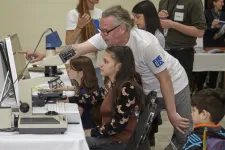(Press-News.org) Key Takeaways:
A new study led by the Harvard Pilgrim Health Care Institute sheds light on the trajectory of cardiovascular health (CVH) early in life, which may contribute to CVH disparities in adulthood.
Across demographic subgroups, CVH scores begin to decline at approximately 10 years of age and appear driven by health behaviors rather than health factors.
Key health behaviors to target for improving early-life CVH include better sleep, healthier diet, and reducing smoking.
Boston, MA — Cardiovascular disease (CVD) is a critical public health concern, with risk factors such as high blood pressure, abnormal blood sugar levels, elevated cholesterol, and obesity beginning in childhood. A new study pinpoints the age when cardiovascular health (CVH) trajectories begin to decline, revealing a crucial window for targeted interventions to improve CVH into adolescence and adulthood.
The findings are published December 17 in JAMA Cardiology.
The American Heart Association’s recently introduced Life’s Essential 8 guidelines assess cardiovascular health based on four behavioral (diet, smoking, physical activity, sleep duration) and four health factors (body mass index, blood pressure, blood sugar and cholesterol levels). While the guidelines hold promise to enhance CVH assessment across the lifecourse, U.S. children’s cardiovascular health remains suboptimal: only 2% of children aged 2–19 have optimal CVH scores and fewer than one-third have high scores (80-100 points).
“Though we know that better heart health in childhood is linked to lower risks of coronary issues later in life, the current state of cardiovascular health in US children is less than ideal,” said lead author Izzuddin Aris, Harvard Medical School assistant professor of population medicine at the Harvard Pilgrim Health Care Institute. “Our study provides insight into the trajectory of cardiovascular health in early life, establishing a clear window of opportunity to improve the health of the nation’s children now and into the future.”
Using the Life’s Essential 8 construct, the research team studied data from over 1,500 children from the Project Viva pre-birth cohort in eastern Massachusetts. Participant inclusion required information on at least 3 CVH metrics in early childhood or at least 4 metrics in mid-childhood, early adolescence, or late adolescence. The team assessed 6 CVH metrics in early childhood (diet, smoking, physical activity, sleep duration, BMI, and BP), and up to 8 from mid-childhood to late adolescence.
The authors found that CVH scores start to decline around age 10 across all demographic groups, driven by health behaviors rather than health factors. This decline may reflect social and/or developmental changes that typically occur at this age—such as changes in school schedules that may interfere with meeting guidelines for healthy sleep duration and/or diet—and may affect health behaviors. Improving these health behaviors, especially between mid-childhood and early adolescence, could help optimize CVH.
They also noted small but significant differences in CVH trajectories based on maternal socioeconomic status and child race and ethnicity.
“Our study highlights the potential early influence of structural factors linked to socioeconomic status and race and ethnicity—such as residence in favorable neighborhood environments, the ability to access healthy foods, and proximity to safe community spaces that encourage physical activity—that might contribute to future cardiovascular health disparities,” adds Dr. Aris. “This, in addition to isolating the most vulnerable age for CVH loss, can help improve targeting of preventive efforts to high-risk children, as well as improve our understanding of the early life drivers of CVH loss.”
About the Harvard Pilgrim Health Care Institute’s Department of Population Medicine
The Harvard Pilgrim Health Care Institute's Department of Population Medicine is a unique collaboration between Harvard Pilgrim Health Care and Harvard Medical School. Created in 1992, it is the first appointing medical school department in the United States based in a health plan. The Institute focuses on improving health care delivery and population health through innovative research and education, in partnership with health plans, delivery systems, and public health agencies. Follow us on X and LinkedIn.
END
New study pinpoints pivotal period for improving cardiovascular health in children
2024-12-18
ELSE PRESS RELEASES FROM THIS DATE:
How sound and vibration converge in the brain to enhance sensory experience
2024-12-18
Ludwig van Beethoven began to lose his hearing at age 28 and was deaf by age 44. While the cause of his hearing loss remains a topic of scientific debate and ongoing revision, one thing is clear: Despite his hearing loss, Beethoven never ceased to compose music, likely because he was able to sense the vibrations of musical instruments and “hear” music through the sense of touch, researchers believe.
Now a study by Harvard Medical School researchers could help explain what enabled Beethoven, ...
iEnergy has been officially included in the ESCI
2024-12-18
We are thrilled to announce that our esteemed academic journal, iEnergy, has been officially included in the Emerging Sources Citation Index (ESCI) by Web of Science, a leading global provider of scientific and scholarly research information. All articles published by iEnergy since its establishment in 2022 will be included in ESCI. And it will receive the first impact factor in 2025.
About iEnergy:
iEnergy is a quarterly journal launched on March 2022. It has published 3 volumes (11 issues), in total 124 papers. Authors come from 21 countries, including ...
Small habitats, big consequences: Connectivity loss in pond networks threatens microbial biodiversity
2024-12-18
In the midst of the ongoing global biodiversity crisis, even the smallest habitats like ponds demand our attention. Fragmentation of these habitats—driven by human activities like urbanization, agriculture, and land-use changes—poses a significant threat to biodiversity. Often overlooked in conservation efforts, ponds serve as vital ecological hotspots, supporting diverse species and sustaining essential ecosystem processes. These waterbodies are home to various microbial communities that, despite their tiny size play an indispensable role in ecosystem functioning, acting ...
Virtual escapes, real benefits: Open-world games boost mental well-being
2024-12-18
(Toronto, December 18, 2024) A study published in the Journal of Medical Internet Research has found that open-world video games can significantly improve relaxation and mental well-being among postgraduate students. Open-world games, known for their expansive environments and player autonomy, offer a form of cognitive escapism that helps players disconnect from daily stressors and enhance their mood.
The study, a collaboration between researchers from Imperial College London, United Kingdom, and the University of Graz, Austria, used a mixed methods approach: they combined survey data from 609 players and in-depth interviews of 32 players. Popular titles like The ...
Survey of 26,000 dead stars confirms key details of extreme stellar behavior
2024-12-18
A study of more than 26,000 white dwarf stars has confirmed a long-predicted but elusive effect in these ultra-dense, dying stars: Hotter white dwarfs are slightly puffier than cooler ones, even when they have the same mass.
The findings bring scientists one step closer to using these stellar objects as natural laboratories to probe the effects of extreme gravity and hunt for exotic dark matter particles. Details about the research, led by Johns Hopkins University, are published in The Astrophysical Journal.
“White dwarfs are one of the best characterized stars that we can work with ...
Community scientists at the Field Museum have digitized more than a quarter-million items and records
2024-12-18
There are over three billion specimens and cultural objects housed in natural history collections around the world—things like fossils, dried plants, and pinned insects. Close to forty million of them are at the Field Museum in Chicago, mostly behind the scenes in a vast library documenting life on Earth. These collections are used by scientists at the museum and around the world to explore what lived where and when and how living things have changed over time.
However, much of the information about these collections is hard to access, ...
New recommendations to increase transparency and tackle potential bias in medical AI technologies
2024-12-18
Patients will be better able to benefit from innovations in medical artificial intelligence (AI) if a new set of internationally-agreed recommendations are followed.
A new set of recommendations published in The Lancet Digital Health and NEJM AI aims to help improve the way datasets are used to build Artificial intelligence (AI) health technologies and reduce the risk of potential AI bias.
Innovative medical AI technologies may improve diagnosis and treatment for patients, however some studies have shown that medical AI can be biased, meaning that it works well for some people and not for others. This means some individuals and communities may be ‘left ...
Davos Alzheimer’s Collaborative and pharmaceutical and diagnostics companies work together on Alzheimer’s disease blood biomarker validation
2024-12-18
The Davos Alzheimer’s Collaborative (DAC), a pioneering worldwide initiative seeking to cure Alzheimer’s disease and improve brain health, today announced they will work with Janssen Research & Development, LLC, a Johnson & Johnson company, and Beckman Coulter Diagnostics, two leading pharmaceutical and diagnostics companies, to advance the assay validation of blood-based biomarkers (BBMs) for Alzheimer’s disease for global use in diverse populations.
DAC, via its Global Cohorts Program, has enabled ...
Bio-electrochemical cell producing hydrogen from microorganisms in waste: Pathway to large-scale implementation unveiled
2024-12-18
Dr. Jwa Eunjin and her research team at the Korea Institute of Energy Research (KIER) have achieved a significant breakthrough in clean energy technology. The team has successfully enhanced a crucial component of a bio-electrochemical cell, enabling more efficient hydrogen production from microorganisms found in waste. This advancement resolves longstanding power loss challenges in conventional processes, offering a transformative pathway toward large-scale, cost-effective hydrogen production.
Biogas, a renewable ...
People from some racial and ethnic groups may face barriers to obtaining obesity medications
2024-12-18
Asians, non-Hispanic Blacks and Hispanics were significantly less likely than whites to use obesity-management medications to lower their weight compared with whites, new research suggests. The differences could not be fully explained by income or education level, health insurance coverage or clinical need.
The study, published in the peer-reviewed Journal of Racial and Ethnic Health Disparities, is one of the few to compare the use of obesity-management medications across racial and ethnic groups, and the first to consider ...






